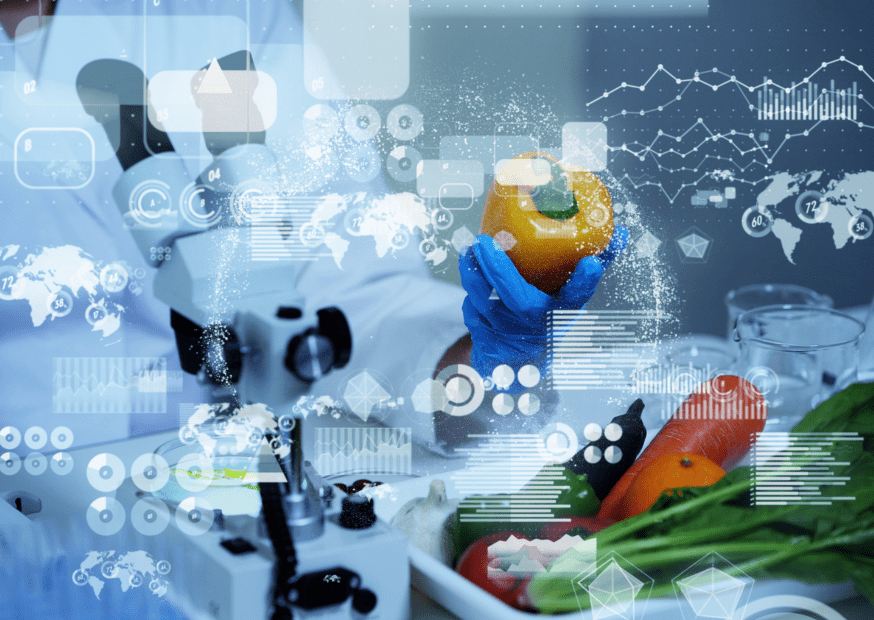Until recently, you wouldn’t immediately link the food industry with innovative ideas and high tech. But the global pandemic has dramatically shifted the market dynamics and accelerated the urgent industry digitization. In the first half of 2021, €3.3B was invested in European food tech companies, with 78% going predictably to delivery startups. By 2027, the global food tech market size is expected to reach $342.52 billion.
However, food tech is a broad concept beyond simply having your groceries brought to your front door. The industry encompasses production, transportation, packaging, delivery, and cooking. The Rocketech experts analyzed the current market situation and summed up the five most promising trends investors consider.

Dominating Business Models
The food market today is driven by reciprocal processes. On the one hand, there is an increase in consumer demand for products. On the other hand, automation and tech innovations bring more possibilities for producing high-quality, customized products. Long-term lockdowns that followed the COVID-19 outbreak created a need for instant e-commerce services. At the same time, businesses had to offer extreme personalization and extra features to meet the “new normal” requirements.
Generally speaking, the food industry incorporates business-to-consumer (B2C) and business-to-business (B2) sectors. Apart from traditional food production, the B2C sector now focuses on food substitutes, personalization, and immediate delivery of specialty products. While organizing interaction between companies remains the center of the B2B model, the pandemic has brought new ideas.
For example, dark stores that had boomed since the beginning of the pandemic inspired an entirely new takeout and delivery business model — ghost kitchens.
| A dark store is a hybrid of a retail store and a warehouse that supplies products exclusively for online shopping. The warehouse employees process and form orders and send them to delivery. Customers cannot enter a dark store. Sometimes dark stores serve as a click-and-collect service link when a customer places an order online and then collects it at the store’s door. |
Similarly, ghost kitchens prepare food for online orders and takeaways only. Only kitchen and restaurant staff, chefs, and couriers can enter dark kitchens. And they don’t allow any customer in-door sitting. This emerging business model has created a new market demand for physical locations. However, due to regulations regarding food preparation and industry hygiene standards, the offer is limited to specialized facilities. As a result, big restaurants rent parts of their professionally well-equipped kitchens to small delivery businesses.
Food Tech: Five Trends of the Future
One way or another, recent food tech and health tech trends are encouraged by sustainability initiatives. Population growth and its impact on food security, society digitization, climate change, natural resource scarcity, food waste, and the environmental impact of food production are the challenging issues humanity is facing. And young trendsetting startups address these problems more often.

Alt Protein
The human population is growing, and so is the need for protein. The UN predicts the world’s population to increase by another 2 billion people by 2050. Apart from environmentalists linking agricultural production to climate change, there’s also a moral dimension to the matter. A combination of factors has led to new alternatives.
Alt protein stands for “alternative protein” and includes various ways to produce healthy substitutes for meat. Plant-based options are the most common type and an already established market that reached $4.98 billion in 2020.
Successful Examples
- Beyond Meat offers plant-based substitutes for pork, beef, and poultry. Total funding amount: $122M.
- THIS produces high-in-protein and meat-tasting plant-based substitution for meat products, including their specialty — bacon. Total funding amount: $28.4M.
Sustainable Packaging
Reduce, reuse, recycle, the main trend in the global packaging market is the search for the most environmentally friendly solutions. In fact, it’s not just a trend but a large market that reached $258.35 billion in 2020. It’s widely supported by environmental activists, scientists, and governments worldwide and, therefore, has tremendous growth potential.
Areas of Focus:
- Switching to recyclable materials;
- Replacing plastic with bioplastic or recycled paper;
- Reducing packaging;
- Reutilization;
- Transition to mono-materials;
- Developing new (unconventional) ideas in packaging.
Nutrient Density of Mushrooms
Mushrooms are rich in protein. They quickly grow at minimal cost and have plenty of industrial applications. Similar to plant-based meat substitutions, growing mushrooms appears a steady trend that will develop quickly. Here are the directions attracting the most investments.
- New Cultivation Methods
Mushrooms can grow anywhere — basements, warehouses, grocery stores, and even restaurants. The NY-based startup Smallhold provides businesses and home growers with “grow bags” and combines farming with tech and innovations in logistics.
- Alternative Protein and Ingredient Technology
The biotech company Mushlabs uses mycelium to produce raw ingredients for meat alternatives that appeal both to vegetarians and meat-eaters. Another biotech platform Michroma is among other startups taking the narrow niche of mycelium-based natural food ingredients.
- Packaging
Mycelium-based packaging is expected to be food-safe, compostable, and cheap. Even if such packaging doesn’t go into the right recycling bin, it will decompose rapidly without damaging the environment. Ecovative Design, a biomaterials company producing innovative materials from natural growth processes, has already raised a total of $90.1M.
Personalized Food
Personalizing meal plans based on lifestyles, health status, personal tastes, and cravings is not a new concept. However, it’s a promising food tech trend with growing investment potential.
The near-future directions of personalized nutrition include:
- Integration of personalized nutrition services into the healthcare system;
- Targeting very narrow consumer groups (people with diabetes or cancer patients);
- Integrated platform solutions.
German HelloFresh, one of the niche pioneers, has become the largest meal-kit provider in the United States. After a customer chooses a plan, HelloFresh delivers the exact ingredients with recipes and detailed cooking instructions. All recipes are created by professional chefs and designed to fit different servings, tastes, and preferences. Since 2011, the startup has raised $367.5M and expanded its operations to Western Europe, Canada, Australia, and New Zealand.
Food Waste Reduction
The world generates over 2 billion tonnes of municipal solid waste annually. And at least 33% of that amount doesn’t make it to governmentally regulated landfills. According to the 2021 UNEP Food Waste Index Report, about 931 million tons of food, or 17% of the total amount of food available to consumers, end up in the garbage containers of households, retailers, restaurants, and other food outlets.
As the issue grows on a global scale, customers are encouraged to make more active choices about purchasing and using food to produce less waste. Meanwhile, retailers focus on using technology to track and manage food supply chains and applying this knowledge to innovation. In these circumstances, zero-waste initiatives have gone beyond NGO practices and taken up a part of the global food tech market.
AI-Driven Innovations
LMK Group, a leader in Scandinavian food tech, offers home meal kit delivery. In 2020, they reached the 1.74 million-kit mark. Using a purpose-specific machine learning model, LMK took the process of predicting probable orders to a whole new level. The company provides its manufacturers and suppliers with an accurate forecast of up to ten weeks in advance. It means that farmers don’t grow crops they won’t eventually use. Today, LMK Group tries to hit less than 1% of food waste — an unprecedented rate for the food retail sector.
Several startups have already entered the market with AI-powered monitoring solutions in the B2B sector.
Phood developed an innovative solution that tracks food waste by matching smart scale with computer vision. It integrates directly with a POS system or the restaurant’s menu and updates the supply chain.
Kitro designed a digital product that tracks and registers food waste and provides real-time data analytics. Sensors placed over the trash bin recognize the waste, analyze it, and translate it into numbers. Every two weeks, the program makes a report helping business owners decide on ingredients they need to buy or the popularity of dishes. The solution reduces food waste by up to 60% and saves significant funds.
Food Tech Attracts Investments
As with any other area, you need to track the latest news and developments in food tech. Although the global pandemic has been a powerful catalyst for the instantaneous rise of some trends in the food industry, the main long-term factors remain the same for a while — the constant population growth and the ecological crisis.
Traditional food giants seeking to take a leading position in food technology, create innovation centers, partner with existing business incubators, help niche brands, and implement cutting-edge technology into their production. Investments in food tech startups appear long-term rather than speculative.
At Rocketech, we help companies across industries create working and successful digital products. Whether it’s a local delivery app or a global sustainability project, we are excited to hear new ideas and assist our partners in bringing them to life.
Get a free discovery call.